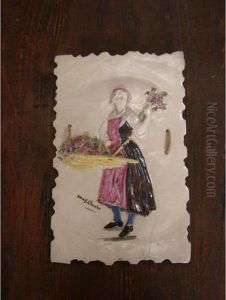Max Claudet Paintings
Max Claudet was a French artist born on October 23, 1840, in Salins-les-Bains in the Jura department of France. His full name was Jules-Claude-Maxime Claudet, but he is commonly known as Max Claudet. Claudet was not only an accomplished painter but also a noted ceramist and photographer, showcasing a versatile talent in the visual arts. His contributions, particularly in ceramics, have been recognized for their innovative techniques and artistic quality, contributing to the revival of ceramic art in France during the late 19th century.
Max Claudet's early life was shaped by his family's artistic background. His father, Aimé Claudet, was a notable figure in the field of photography, being a pioneer in the development of the daguerreotype process, a method of early photography. This environment undoubtedly influenced Max's interest in the arts and his subsequent career path. Despite the prominence of photography in his family, Claudet chose to explore various mediums throughout his career, including painting and ceramics.
In ceramics, Claudet achieved significant acclaim for his work with stoneware, a material he experimented with extensively. His efforts in this area were recognized as part of the broader Art Nouveau movement, which sought to elevate the status of decorative arts to that of fine arts. Claudet's work in ceramics was characterized by its innovation, quality of craftsmanship, and the application of unique glazes, which contributed to the distinctive appearance of his pieces. His achievements in this field were acknowledged with awards at international exhibitions, reinforcing his status as a leading figure in the revival of ceramic art in France.
Despite his success in ceramics, Claudet also continued to engage in photography and painting, demonstrating a broad artistic skill set. His paintings, though less known compared to his ceramic works, displayed a keen observation of nature and a delicate handling of light and color, which were admired by his contemporaries.
Max Claudet's contribution to the arts was cut short by his untimely death on November 23, 1893, in Paris. In his relatively brief career, he left a significant mark on the French art scene of the late 19th century, particularly in the field of ceramics. His innovative approach to materials and techniques, along with his commitment to aesthetic excellence, ensured that his work remained influential beyond his lifetime. Today, Claudet is remembered as a pioneering artist whose contributions helped shape the course of French art in the period leading up to the modernist movements of the early 20th century.


